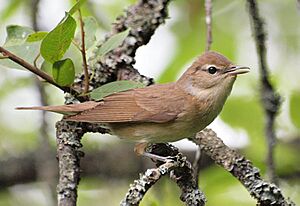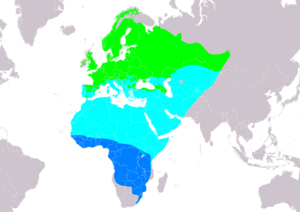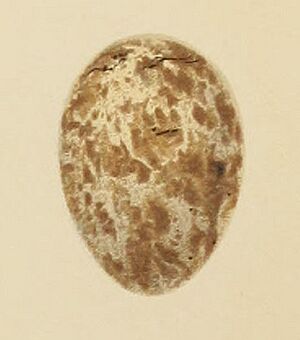Garden warbler facts for kids
Quick facts for kids Garden warbler |
|
|---|---|
 |
|
| The nominate subspecies in Sweden | |
| Conservation status | |
| Scientific classification | |
| Genus: |
Sylvia
|
| Species: |
borin
|
| Subspecies | |
|
|
 |
|
| Range of S. borin (Compiled by: BirdLife International and Handbook of the Birds of the World (2016) 2009). Breeding Passage Non-breeding | |
The garden warbler (Sylvia borin) is a common small bird. It lives and breeds across much of Europe and western Siberia. This bird is plain brown on top and dull white underneath. It has long wings and a long tail. Male and female garden warblers look very similar. Young birds also look like the adults.
The garden warbler's beautiful song sounds a lot like its closest relative, the blackcap. These two birds sometimes compete for nesting areas. Even though it's called a "garden warbler," it usually prefers open woodlands with thick bushes. It rarely lives in actual gardens.
Garden warblers are strong migratory birds. They fly all the way to sub-Saharan Africa for the winter. In Africa, they use many different habitats. They avoid dense forests and treeless areas. During summer, they mainly eat insects. Before migrating, they eat a lot of fruit, especially figs. In winter, their diet is a mix of insects and fruit.
Contents
About the Garden Warbler
What is a Garden Warbler?
The garden warbler is about 14 centimeters (5.5 inches) long. Its wings are about 7.6 to 8.4 centimeters (3 to 3.3 inches) long. It usually weighs between 16 and 22 grams (0.6 to 0.8 ounces). But before migration, it can weigh up to 35.5 grams (1.25 ounces).
This bird has olive-brown feathers on its back and dull white feathers on its belly. It has a faint pale line above its eye. Its throat and sides have a light buff color. The eye is black, and its legs are bluish-grey. The bill is strong, with a grey top and a lighter grey bottom.
How to Identify a Garden Warbler
Because the garden warbler looks so plain, it can be hard to tell apart from other similar birds.
- Melodious and icterine warblers often have longer bills and a yellowish tint.
- The booted warbler is smaller and more delicate.
- Western and eastern olivaceous warblers are also small. They have white outer tail feathers and a pinkish bill.
- Young barred warblers are much larger and have pale wing bars.
How Does a Garden Warbler Sound?
The male garden warbler sings a rich, musical warble. He usually sings from inside thick bushes. His song lasts a few seconds, but sometimes longer. It can sound like the blackcap's song. However, the garden warbler's song is a bit lower-pitched and smoother.
When the bird is worried, it makes a sharp kek-kek sound. Sometimes, you might hear a quiet, raspy tchurr-r-r-r. Young birds make a quia alarm sound.
Where Garden Warblers Live
Breeding Areas and Migration Routes
Garden warblers breed across most of Europe and east into Siberia. They breed farther north than any other Sylvia warbler. All garden warblers migrate for the winter. They fly to sub-Saharan Africa, as far south as South Africa.
Birds from central Europe first fly southwest. Once in Africa, they turn south or southeast. Scandinavian birds might fly south over the Alps and the Mediterranean Sea. The eastern subspecies, S. b. woodwardi, takes a more easterly route. Many of these birds fly through the Arabian Peninsula.
When crossing the Sahara Desert, they fly at night. During the day, they rest in the shade without eating. They can lose a lot of body fat and even some muscle during this journey. Many birds stop for a few days to eat after crossing the desert.
Wintering Grounds and Habitats
The main subspecies winters in western and central Africa. The S. b. woodwardi subspecies winters in eastern and southern Africa. We don't know much about their movements in Africa. But some birds do return to the same spots each year.
The garden warbler's breeding habitat is open areas with dense bushes. This includes thickets and the edges of woodlands. They like shady spots with lots of bushes or plants underneath. They also like woods near rivers or reed beds. They can live in areas with willow, alder, and birch trees. This allows them to breed farther north and higher up than other European Sylvia warblers. They avoid old conifer forests and dense tree farms.
In Africa, they use many types of habitats with trees. But they still avoid dense forests and very dry areas. They can be found up to 2,600 meters (8,500 feet) high in mountain woodlands.
Garden Warbler Life Cycle
Reproduction and Nesting
Garden warblers start breeding when they are one year old. They usually have one mate for the breeding season. When males return to their breeding areas, they set up a territory. Sylvia warblers are special because they strongly defend their territory. They fight off other birds of their own kind and even other Sylvia species.
Blackcaps and garden warblers use the same types of woods. But they are aggressive towards each other. This means their territories never overlap. There are usually 3 to 9 pairs per hectare (1.2 to 3.6 per acre). In very good habitats, there can be more than 10 pairs per hectare (4 per acre).
A male attracts a female with his song and a special display. He beats his wings fast while perched. He also builds a few simple nests. These are called "cock's nests." The female rarely finishes one of these. She usually starts a new nest herself.
The nest is hidden in plants, often in Rubus species like brambles. It can also be in willows or stinging nettles. The nest is usually between 0.3 and 1.2 meters (1 to 4 feet) above the ground. It is rarely higher than 2 meters (6.5 feet). The nest is a cup made of dry grass, moss, and twigs. It has a soft lining of finer plant material or hair. It is larger and heavier than a blackcap's nest.
The first eggs are laid in late April in southern Germany. In northwest Europe, it's early May. In Finland, it's late May. The breeding season can last until July. A female usually lays four or five eggs. Sometimes it's two to six. The eggs are usually whitish or buff with grey, purple, and brown spots. Each egg is about 20 by 15 millimeters (0.8 by 0.6 inches) and weighs 2.2 grams (0.08 ounces).
Both parents take turns sitting on the eggs. This is called incubation. It lasts for 11 to 12 days. Only the female stays on the nest at night. The chicks are born naked and with their eyes closed. Both parents feed them. The young birds leave the nest about 10 days after hatching. They can't fly well yet. The parents continue to feed them for another two weeks. The family might stay together for a few days after that.
The short time for incubation and fledging helps the chicks leave the nest quickly. This protects them from predators. Only about half of breeding pairs successfully raise at least one young bird. In the UK, over half of nest failures are due to predators. About 30% are due to not enough food in bad weather.
About 50% of adult garden warblers survive each year. Only about 26% of young birds survive their first year. They usually live for two years. But one bird in Sweden lived for over ten years. In captivity, some have lived up to 24 years!
What Do Garden Warblers Eat?
During the breeding season, garden warblers mainly eat insects. They also eat other small invertebrates like spiders. They pick their food off leaves and twigs. Sometimes they hover in the air to catch prey. They usually look for food less than 6 meters (20 feet) above the ground.
After nesting, their diet changes to mostly fruit. They still eat insects while they get fat for migration. Birds gain weight faster when they eat both fruit and insects. They prefer berries and other soft fruits. Figs are very important for birds getting ready to migrate. This is why they are called "fig peckers" in some languages. Eating fruit helps them gain weight quickly.
In Africa, the warbler eats insects and berries. The fruit of the Spanish flag plant is a favorite. They gain weight again before flying north. They get fat even faster than before their trip south.
Garden warblers often feed with other birds of their kind. They also feed with other fruit-eating birds. Over 35 plant species have been recorded as food for this warbler in central Europe alone. Many more are eaten in the Mediterranean and African wintering areas.
Threats to Garden Warblers
Predators and Parasites
The main predators of the garden warbler are Eurasian sparrowhawks and domestic cats. Some falcons also hunt adult warblers. Eurasian jays and Eurasian magpies eat the eggs and young birds. Mammals like stoats, weasels, and squirrels also take eggs and young.
The garden warbler is a host for the common cuckoo. This means the cuckoo lays its eggs in the warbler's nest. The warbler then raises the cuckoo chick.
Garden warblers can have external parasites like fleas and mites. They can also have internal parasites.
Conservation Status
The garden warbler lives in a very large area, about 9.65 million square kilometers (3.7 million square miles). Its population in Europe is estimated to be between 17 and 31 million breeding pairs. Including birds in Asia, the total population is between 54 and 124 million individuals.
There is no sign of a serious drop in their numbers. So, the International Union for Conservation of Nature (IUCN) lists the garden warbler as a species of least concern. This means it is not currently at risk of extinction.
There has been a small decline in numbers in Europe since 1980. However, the population in Scandinavia is growing. Climate change seems to be affecting the migration of garden warblers and blackcaps. Both are arriving in Europe earlier than before. Young garden warblers are also leaving almost two weeks later than in the 1980s. Birds of both species have longer wings and are lighter than in the past. This suggests they are flying longer distances as their breeding range expands north.
Garden Warblers in Culture
In ancient Greece, the philosopher Aristotle thought the garden warbler changed into a blackcap. The composer Olivier Messiaen used the garden warbler's song in his 1971 piano piece, La fauvette des jardins. The title means "the garden warbler" in French.
The garden warbler is considered a special food in some Mediterranean countries. An Italian stuffed sardine dish, sarde a beccafico, gets its name from its supposed resemblance to cooked garden warblers. In Italy, the bird is called beccafico, meaning "fig-pecker."
Old English names for the garden warbler included "strawsmear," "small straw," and "haychat." These names often came from the materials the bird used for its nest. The most common old English name was "pettychaps." These names were sometimes used for other warblers too.



